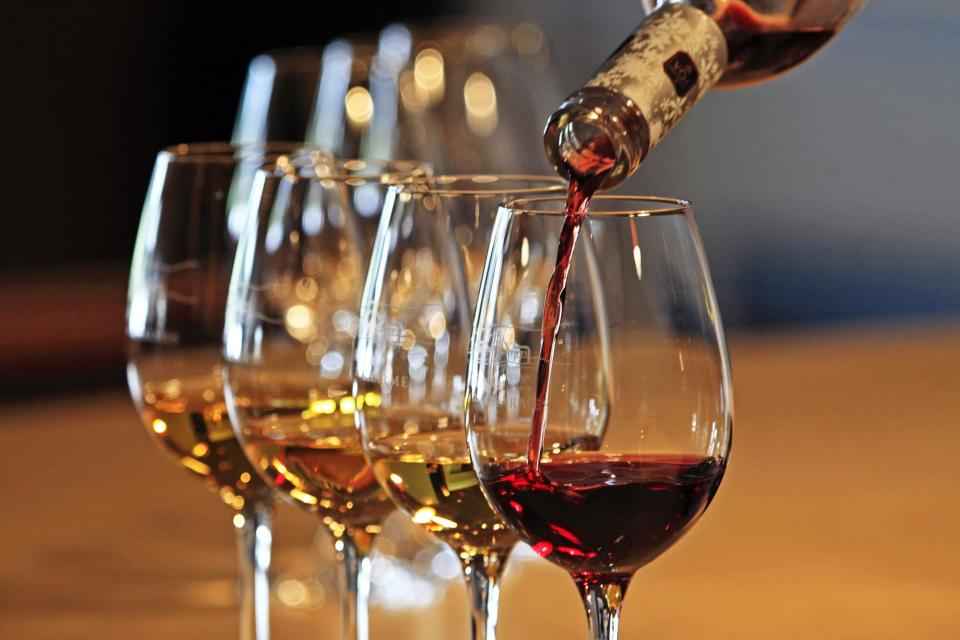6 Common Myths About Sweet Wine
If hearing the words "sweet wine" conjures a neon pink bottle of glorified cough syrup, you're not alone. While sweet wine, also known as dessert wine, has been meticulously-made and highly-prized for centuries, it's taken a reputation hit in recent decades thanks to cloying, mass-market bottles that were all the rage in the mid-1980s. But not all sweet wines are created equal.
"White Zinfandel gave wine with sugar a poor reputation because they were mass-produced and poor quality wines," says Amy Racine, Beverage Director for New York's IRIS and JF Restaurants. A Riesling from a small German producer, or an off-dry Chenin Blanc from Vouvray, or a Sauternes, is a world away, she says. "These wines are extremely difficult to make, high quality, and most important, have balance."

Bruce Yuanyue Bi / Getty Images
And while dessert wines come in a diverse range, from red and white to sparkling, Jonathan Feiler, group director of wine for Ocean House Collection in Rhode Island, suggests trying one from a winery you already love for its dry wine. "There is one out there for everyone," he says.
Related: Maximum Coziness Is an Evening Glass of Sweet Wine
Below, wine pros weigh in on the many misconceptions about sweet wine, and why now is the time to try a bottle and judge for yourself.
Sweet wine only pairs with dessert
"I always skip the dessert and make the sweet wine my dessert," says Paola Embry, wine director and CEO at Wrigley Mansion in Phoenix, Arizona. Embry also likes to pair a glass with courses beyond dessert—a cheese course, or between courses with foie gras, for example—noting, "It does not have to be with something necessarily sweet, or even at the end of a meal."
"The biggest misconception is that they're only intended for dessert, but the semi-sweet styles work brilliantly matched to spicy notes like chilies and ginger," adds Mya Brown, wine director at Botanist, Fairmont Pacific Rim in Vancouver. She suggests looking for high-acid sweet whites like Rieslings to pair with spiced foods, serving them as an aperitif, or to match with a variety of cheeses or foie gras. "There's such a wide spectrum of different styles and levels of sweetness available, so I find there is more versatility to them than most people expect."
All dessert wines have added sugar
"In fact, many dessert wines have what we call residual sugar, meaning that there is no added sugar, it is the natural sugar from the grapes that are not fermented out, and left in the wine," says Feiler.
And while sweet wine can have a reputation for being unhealthy, most wines start with the same amount of sugar and that is converted to alcohol, says Racine. "Also, many people are drinking sugary coffee drinks, or treat themselves to a pastry," she adds, "and I think wine should be the same way."
Sweet wines are cheap
While the sweet wine category is awash in $4.99 bottles of Arbor Mist, not all are low-priced. "Some of the world's most expensive and rare wines are sweet, such as Château D' Yquem from the Bordeaux region in France and the great Hungarian wines of Tokaji, and even more so the wines of Madeira," says Simon Roberts, owner at Graileys Wine Cellar and co-owner of Tango Room in Dallas. "All can be highly sought after."
Sweet wines are one-dimensional
"The biggest misconception about sweet wine is that it is lacking much depth," says Cheron Cowan, beverage director at Maialino Mare, in Washington, DC. Cowan, who gravitates toward Italian wines, points to Lambrusco made with the Grasparossa di Castelvetro grape to challenge that notion. "This particular varietal tends to offer Lambruscos with more girth on the palate, even when off-dry," she says, adding that she also loves more obscure finds, like the Vernaccia di Serrapetrona off-dry sparkling reds from the Marche region in Italy. "They can offer a vibrant acidity and firm tannins, in addition to the sweetness, thus opening up the pairing spectrum to something more uniquely savory."
All Rieslings and rosé wines are sweet.
In fact, says Jonathan Feiler, there are very few sweet Rosés, and most Rieslings are dry. "But the sweet ones can be very well balanced and age incredibly well," he says of the latter.
Sean Rouch, F&B manager at Marigold by Jean-Georges in Keswick, Virginia, loves both dry and sweet Riesling. Specifically, he says the Spätlese category—meaning the wine is made with late harvest, fully-ripe grapes—includes wines that are among the most expressive and versatile. "The residual sugar combined with piercing acidity is a magical combination and can compliment a wide variety of dishes," he says. "The sweetness has the ability to tamp down heat from spices and peppers while imparting an exotic honey and fruit note, while the acidity of Riesling simultaneously cleanses and refreshes the palate."
All sweet wines are thick and syrupy.
Though sweet wines can have upwards of 100 grams of sugar per liter, many have enough acidity to keep them well-balanced, instead of cloying, notes Feiler.
"The quality sweet wines of the world, like Sauternes and German Riesling, have a lot of acidity to make the wine balance out, while others, like Madeira or Port, have heat from a grape-based spirit being added," says Racine. "Dessert Champagne has bubbles and acidity." Racine suggests starting with the basics, and asking your trusted wine retailer for recommendations of a classic example of a great German Riesling, Alsatian white, or Loire Chenin Blanc. "Let them know you're seeking balance and what they would recommend as a solid representation of that area."

